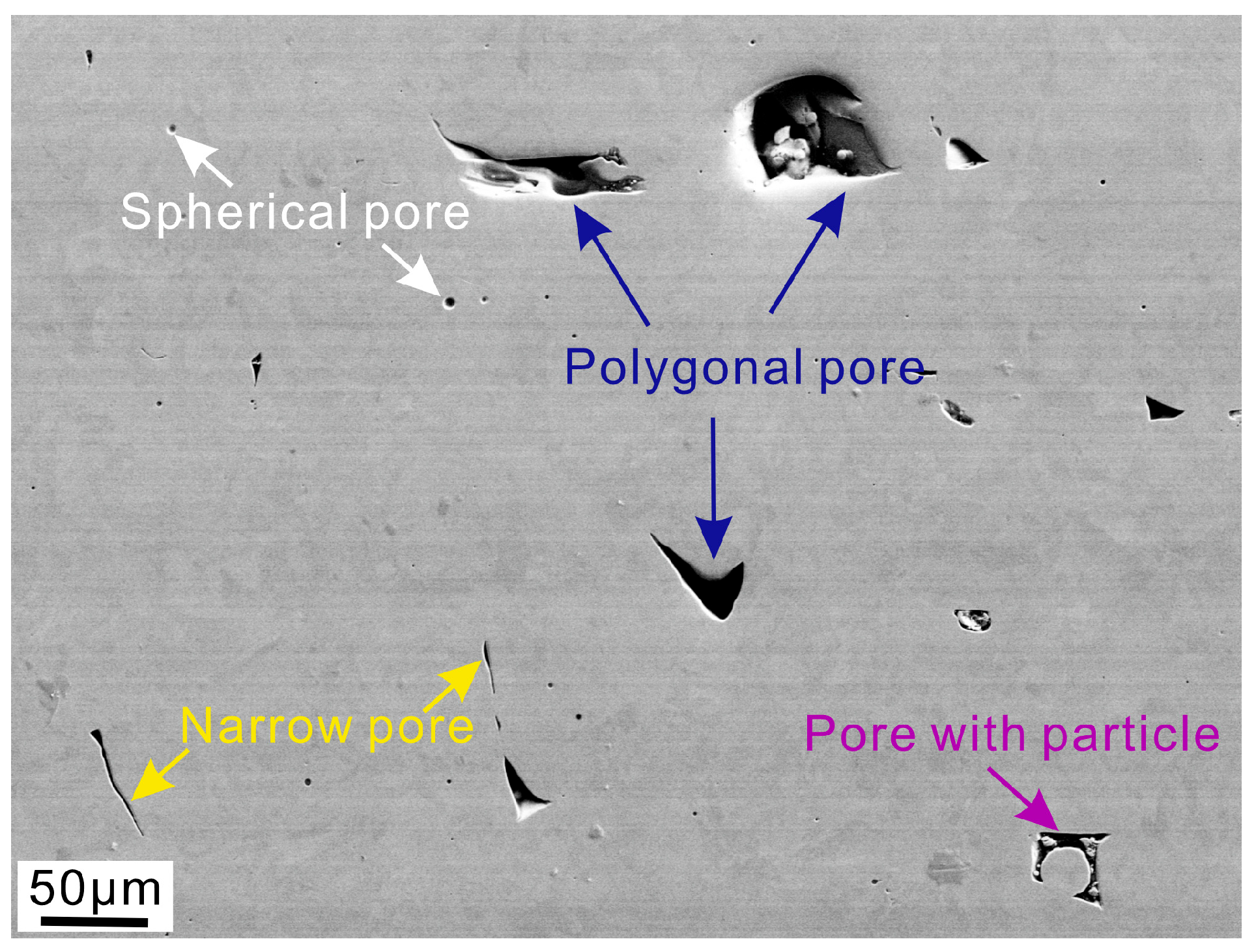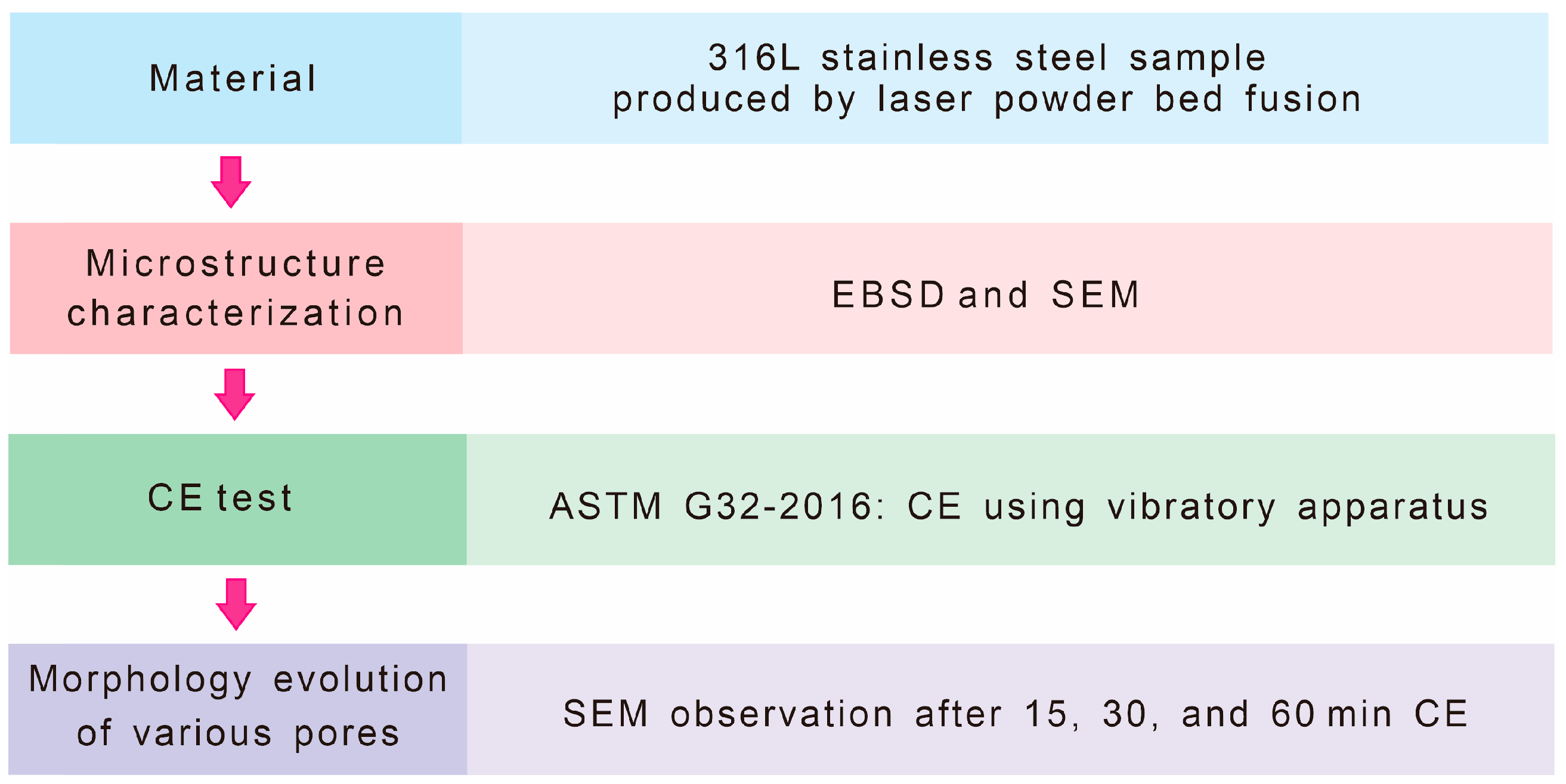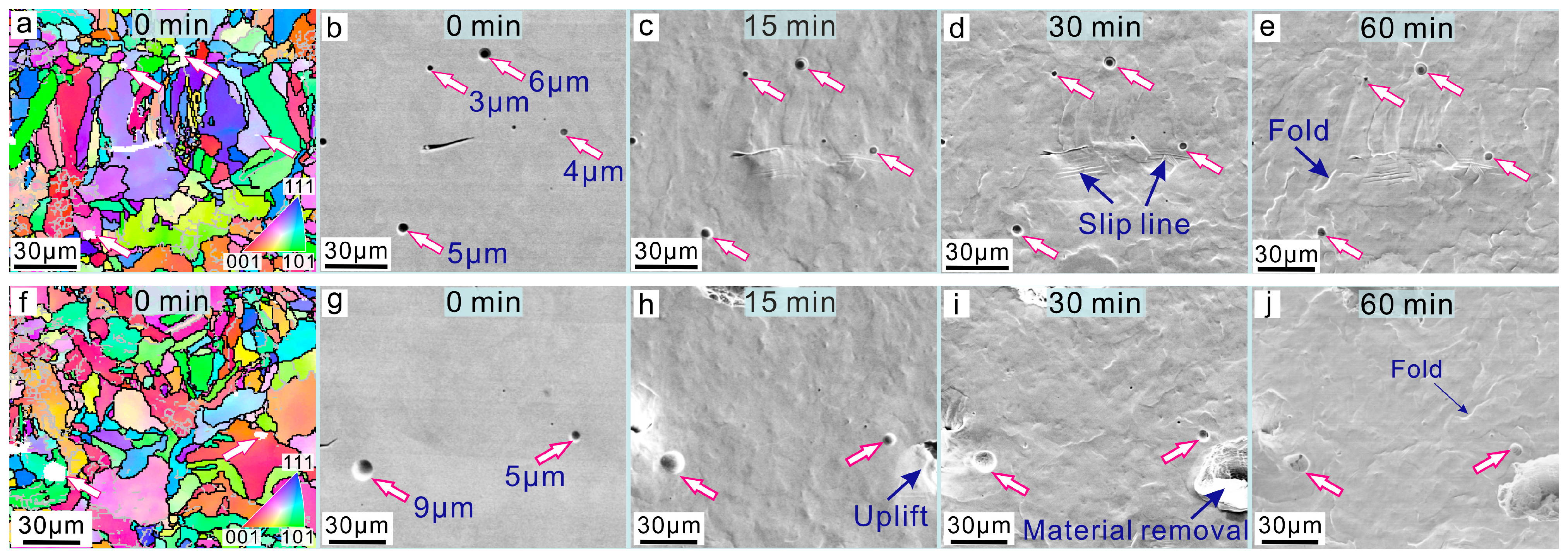The Role of Pores in the Cavitation Erosion of Additively Manufactured Metal: An In Situ Study
Abstract
1. Introduction
2. Materials and Methods
3. Results and Discussion
3.1. Role of Polygonal Pores in CE
3.2. Role of Narrow Pores in CE
3.3. Role of Spherical Pores in CE
3.4. Role of Pores with Powder Particles in CE
3.5. Size and Shape Effects of the Pores
3.6. Improving the CE Resistance of AM Metals
4. Conclusions
Author Contributions
Funding
Data Availability Statement
Conflicts of Interest
Abbreviations
| AM | Additively manufactured |
| CE | Cavitation erosion |
| SEM | Scanning electron microscope |
| EBSD | Electron backscatter diffraction |
References
- Mukherjee, T.; Elmer, J.W.; Wei, H.L.; Lienert, T.J.; Zhang, W.; Kou, S.; DebRoy, T. Control of grain structure, phases, and defects in additive manufacturing of high-performance metallic components. Prog. Mater. Sci. 2023, 138, 101153. [Google Scholar] [CrossRef]
- Sanaei, N.; Fatemi, A. Defects in additive manufactured metals and their effect on fatigue performance: A state-of-the-art review. Prog. Mater. Sci. 2021, 117, 100724. [Google Scholar] [CrossRef]
- Ren, Z.; Gao, L.; Clark, S.J.; Fezzaa, K.; Shevchenko, P.; Choi, A.; Everhart, W.; Rollett, A.D.; Chen, L.; Sun, T. Machine learning-aided real-time detection of keyhole pore generation in laser powder bed fusion. Science 2023, 379, 89–93. [Google Scholar] [CrossRef] [PubMed]
- Laleh, M.; Hughes, A.E.; Yang, S.; Wang, J.; Li, J.; Glenn, A.M.; Xu, W.; Tan, M.Y. A critical insight into lack-of-fusion pore structures in AM stainless steel. Addit. Manuf. 2021, 38, 101762. [Google Scholar]
- Li, E.; Zhou, Z.; Wang, L.; Zou, R.; Yu, A. Numerical studies of melt pool and gas bubble dynamics in laser powder bed fusion process. Addit. Manuf. 2022, 56, 102913. [Google Scholar] [CrossRef]
- Vandecasteele, M.; Heylen, R.; Iuso, D.; Thanki, A.; Philips, W.; Witvrouw, A.; Verhees, D.; Booth, B.G. Towards materials and process agnostic features for the classification of pore types in metal additive manufacturing. Mater. Des. 2023, 227, 111757. [Google Scholar] [CrossRef]
- Fan, F.; Jiang, M.; Wang, P.; Liu, C.; Liu, Z.; Chen, Z. Defect-associated microstructure evolution and deformation heterogeneities in additively manufactured 316L stainless steel. Mater. Sci. Eng. A 2022, 861, 144287. [Google Scholar] [CrossRef]
- Chen, L.; Yao, X.; Tan, C.; He, W.; Su, J.; Weng, F.; Chew, Y.; Ng, N.P.H.; Moon, S.K. In-situ crack and keyhole pore detection in laser directed energy deposition through acoustic signal and deep learning. Addit. Manuf. 2023, 69, 103547. [Google Scholar] [CrossRef]
- Zhao, C.; Parab, N.D.; Li, X.; Fezzaa, K.; Tan, W.; Rollett, A.D.; Sun, T. Critical instability at moving keyhole tip generates porosity in laser melting. Science 2020, 370, 1080–1086. [Google Scholar] [CrossRef]
- Yu, T.; Zhao, J. Quantifying the mechanisms of keyhole pore evolution and the role of metal-vapor condensation in laser powder bed fusion. Addit. Manuf. 2023, 72, 103642. [Google Scholar] [CrossRef]
- Stopka, K.S.; Desrosiers, A.; Nicodemus, T.; Krutz, N.; Andreaco, A.; Sangid, M.D. Intentionally seeding pores in AM alloy 718: Process parameters, microstructure, defects, and fatigue. Addit. Manuf. 2023, 66, 103450. [Google Scholar]
- Fiegl, T.; Franke, M.; Körner, C. Correlation of powder degradation, energy absorption and gas pore formation in laser-based powder bed fusion process of AlSi10Mg0.4. Addit. Manuf. 2022, 56, 102917. [Google Scholar] [CrossRef]
- Mostafaei, A.; Ghiaasiaan, R.; Ho, I.T.; Strayer, S.; Chang, K.C.; Shamsaei, N.; Shao, S.; Paul, S.; Yeh, A.C.; Tin, S.; et al. Additive manufacturing of nickel-based superalloys: A state-of-art review on process-structure-defect-property relationship. Prog. Mater. Sci. 2023, 136, 101108. [Google Scholar] [CrossRef]
- Zhang, R.; Li, W.; Jiao, Y.; Paniagua, C.; Ren, Y.; Lu, H. Porosity evolution under increasing tension in wire-arc additively manufactured aluminum using in-situ micro-computed tomography and convolutional neural network. Scr. Mater. 2023, 225, 115172. [Google Scholar] [CrossRef]
- Luo, Y.W.; Zhang, B.; Feng, X.; Song, Z.M.; Qi, X.B.; Li, C.P.; Chen, G.F.; Zhang, G.P. Pore-affected fatigue life scattering and prediction of additively manufactured Inconel 718: An investigation based on miniature specimen testing and machine learning approach. Mater. Sci. Eng. A 2021, 802, 140693. [Google Scholar] [CrossRef]
- Yang, Y.; Hu, L.; Huang, J. Effect of microstructure and printed pores on the adiabatic shearing behavior of Ti6Al4V titanium alloy manufactured by selective electron beam melting. Mater. Charact. 2023, 196, 112642. [Google Scholar] [CrossRef]
- Gonzalez-Avila, S.R.; Nguyen, D.M.; Arunachalam, S.; Domingues, E.M.; Mishra, H.; Ohl, C.D. Mitigating cavitation erosion using biomimetic gas-entrapping microtextured surfaces (GEMS). Sci. Adv. 2020, 6, eaax6192. [Google Scholar] [CrossRef]
- McClintock, D.A.; Liu, Y.; Bruce, D.R.; Winder, D.E.; Schwartz, R.G.; Kyte, M.; Blokland, W.; Sangrey, R.L.; Carroll, T.M.; Long, C.D.; et al. Small-bubble gas injection to mitigate cavitation-induced erosion damage and reduce strain in target vessels at the spallation neutron source. Mater. Des. 2022, 221, 110937. [Google Scholar] [CrossRef]
- Reuter, F.; Deiter, C.; Ohl, C.D. Cavitation erosion by shockwave self-focusing of a single bubble. Ultrason. Sonochem. 2022, 90, 106131. [Google Scholar] [CrossRef]
- Dong, F.; Li, X.; Zhang, L.; Ma, L.; Li, R. Cavitation erosion mechanism of titanium alloy radiation rods in aluminum melt. Ultrason. Sonochem. 2016, 31, 150–156. [Google Scholar] [CrossRef]
- Mo, X.; Wang, J.; Cheng, L.; Ouyang, T. Numerical prediction of vibration-induced cavitation erosion in high-speed gears using erosion risk indicators. Tribol. Int. 2023, 179, 108122. [Google Scholar] [CrossRef]
- Cheng, F.; Wu, F.; Wang, S.; Peng, X.; Cao, Y.; Yang, S. A prediction model for suction cavitation erosion in a journal bearing. Tribol. Int. 2023, 184, 108424. [Google Scholar] [CrossRef]
- Sreedhar, B.K.; Albert, S.K.; Pandit, A.B. Cavitation damage: Theory and measurements—A review. Wear 2017, 372−373, 177–196. [Google Scholar] [CrossRef]
- Wang, Z.; Wang, Y. Cavitation erosion and its effect on corrosion resistance of nuclear-grade Z3CN20-09M stainless steel. Mater. Des. 2022, 221, 110978. [Google Scholar] [CrossRef]
- Hou, G.; Ren, Y.; Zhang, X.; Dong, F.; An, Y.; Zhao, X.; Zhou, H.; Chen, J. Cavitation erosion mechanisms in Co-based coating exposed to seawater. Ultrason. Sonochem. 2020, 60, 104799. [Google Scholar] [CrossRef]
- Chen, S.Y.; Xu, W.L.; Luo, J.; Li, J.B.; Zhai, Y.W. Experimental study on the mesoscale causes of the effect of sediment size and concentration on material cavitation erosion in sandy water. Wear 2022, 488–489, 204114. [Google Scholar] [CrossRef]
- Cheng, J.; Wu, Y.; Hong, S.; Cheng, J.; Qiao, L.; Wang, Y.; Zhu, S. Cavitation-erosion behavior and mechanism of high-velocity oxygen-fuel sprayed CuAlNiTiSi medium-entropy alloy coating. Surf. Coat. Technol. 2022, 432, 128096. [Google Scholar] [CrossRef]
- Wang, Z.; Wang, Y. Hydrogen participates in cavitation erosion in water. Wear 2022, 504–505, 204435. [Google Scholar] [CrossRef]
- Qiao, Y.; Chen, J.; Zhou, H.; Wang, Y.; Song, Q.; Li, H.; Zheng, Z. Effect of solution treatment on cavitation erosion behavior of high-nitrogen austenitic stainless steel. Wear 2019, 424–425, 70–77. [Google Scholar] [CrossRef]
- Girelli, L.; Tocci, M.; Montesano, L.; Gelfi, M.; Pola, A. Investigation of cavitation erosion resistance of AlSi10Mg alloy for additive manufacturing. Wear 2018, 402–403, 124–136. [Google Scholar] [CrossRef]
- Guse, F.; Voshage, M.; Schleifenbaum, J.H.; Schmitz, K. Cavitation erosion resistance of additive manufactured materials. Chem. Eng. Technol. 2023, 46, 37–44. [Google Scholar] [CrossRef]
- Ding, H.; Tang, Q.; Zhu, Y.; Zhang, C.; Yang, H. Cavitation erosion resistance of 316L stainless steel fabricated using selective laser melting. Friction 2021, 9, 1580–1598. [Google Scholar] [CrossRef]
- Sasaki, H.; Takeo, F.; Soyama, H. Cavitation erosion resistance of the titanium alloy Ti-6Al-4V manufactured through additive manufacturing with various peeing methods. Wear 2020, 462–463, 203518. [Google Scholar] [CrossRef]
- Hardes, C.; Pöhl, F.; Röttger, A.; Thiele, M.; Theisen, W.; Esen, C. Cavitation erosion resistance of 316L austenitic steel processed by selective laser melting (SLM). Addit. Manuf. 2019, 29, 100786. [Google Scholar] [CrossRef]
- Tian, Y.; Zhao, H.; Yang, R.; Liu, X.; Chen, X.; Qin, J.; McDonald, A.; Li, H. In-situ SEM investigation on stress-induced microstructure evolution of austenitic stainless steel subjected to cavitation erosion and cavitation erosion-corrosion. Mater. Des. 2022, 213, 110314. [Google Scholar] [CrossRef]
- Wilson-Heid, A.E.; Beese, A.M. Combined effects of porosity and stress state on the failure behavior of laser powder bed fusion stainless steel 316L. Addit. Manuf. 2021, 39, 101862. [Google Scholar] [CrossRef]
- Plessis, A.; Yadroitsava, I.; Yadroitsev, I. Effects of defects on mechanical properties in metal additive manufacturing: A review focusing on X-ray tomography insights. Mater. Des. 2020, 187, 108385. [Google Scholar] [CrossRef]
- Prithivirajan, V.; Sangid, M.D. The role of defects and critical pore size analysis in the fatigue response of additively manufactured IN718 via crystal plasticity. Mater. Des. 2018, 150, 139–153. [Google Scholar] [CrossRef]
- Kumar, P.; Jayaraj, R.; Suryawanshi, J.; Satwik, U.R.; McKinnell, J.; Ramamurty, U. Fatigue strength of additively manufactured 316L austenitic stainless steel. Acta Mater. 2020, 199, 225–239. [Google Scholar] [CrossRef]
- Laleh, M.; Sadeghi, E.; Revilla, R.I.; Chao, Q.; Haghdadi, N.; Hughes, A.E.; Xu, W.; De Graeve, I.; Qian, M.; Gibson, I.; et al. Heat treatment for metal additive manufacturing. Prog. Mater. Sci. 2023, 133, 101051. [Google Scholar] [CrossRef]
- ASTM G32-16; Standard Test Method for Cavitation Erosion Using Vibratory Apparatus. ASTM International: West Conshohocken, PA, USA, 2016. [CrossRef]
- Sinclair, L.; Leung, C.L.A.; Marussi, S.; Clark, S.J.; Chen, Y.; Olbinado, M.P.; Rack, A.; Gardy, J.; Baxter, G.J.; Lee, P.D. In situ radiographic and ex situ tomographic analysis of pore interactions during multilayer builds in laser powder bed fusion. Addit. Manuf. 2020, 36, 101512. [Google Scholar] [CrossRef]
- Dular, M.; Ohl, C.D. Bulk material influence on the aggressiveness of cavitation—Questioning the microject impact influence and suggesting a possible way to erosion mitigation. Wear 2023, 530–531, 205061. [Google Scholar] [CrossRef]
- Gonzalez-Parra, J.C.; Robles, V.; Devia-Cruz, L.F.; Rodriguez-Beltran, R.I.; Cuando-Espitia, N.; Camacho-Lopez, S.; Aguilar, G. Mitigation of cavitation erosion using laser-induced periodic surface structures. Surf. Interfaces 2022, 29, 101692. [Google Scholar] [CrossRef]
- France, J.P.; Michel, J.M. Fundamentals of Cavitation, 1st ed.; Kluwer Academic Publishers: New York, NY, USA, 2005. [Google Scholar] [CrossRef]
- Zhang, W.; Chabok, A.; Kooi, B.J.; Pei, Y. Additive manufacturing high entropy alloys: A review of the microstructure and properties. Mater. Des. 2022, 220, 110875. [Google Scholar] [CrossRef]
- Wang, Z.; Zhang, B. Cavitation erosion behavior of high-nitrogen austenitic stainless steel: Effect and design of grain-boundary characteristics. Mater. Des. 2021, 201, 109496. [Google Scholar] [CrossRef]
- Krella, A.; Marchewicz, A. Effect of mechanical properties of CrN/CrCN coatings and uncoated 1.402 stainless steel on the evolution of degradation and surface roughness in cavitation erosion. Tribol. Int. 2023, 177, 107991. [Google Scholar] [CrossRef]








Disclaimer/Publisher’s Note: The statements, opinions and data contained in all publications are solely those of the individual author(s) and contributor(s) and not of MDPI and/or the editor(s). MDPI and/or the editor(s) disclaim responsibility for any injury to people or property resulting from any ideas, methods, instructions or products referred to in the content. |
© 2025 by the authors. Licensee MDPI, Basel, Switzerland. This article is an open access article distributed under the terms and conditions of the Creative Commons Attribution (CC BY) license (https://creativecommons.org/licenses/by/4.0/).
Share and Cite
Song, Y.; Wang, Z.; Ma, B. The Role of Pores in the Cavitation Erosion of Additively Manufactured Metal: An In Situ Study. Metals 2025, 15, 787. https://doi.org/10.3390/met15070787
Song Y, Wang Z, Ma B. The Role of Pores in the Cavitation Erosion of Additively Manufactured Metal: An In Situ Study. Metals. 2025; 15(7):787. https://doi.org/10.3390/met15070787
Chicago/Turabian StyleSong, Yuan, Zhenhua Wang, and Bingyang Ma. 2025. "The Role of Pores in the Cavitation Erosion of Additively Manufactured Metal: An In Situ Study" Metals 15, no. 7: 787. https://doi.org/10.3390/met15070787
APA StyleSong, Y., Wang, Z., & Ma, B. (2025). The Role of Pores in the Cavitation Erosion of Additively Manufactured Metal: An In Situ Study. Metals, 15(7), 787. https://doi.org/10.3390/met15070787






